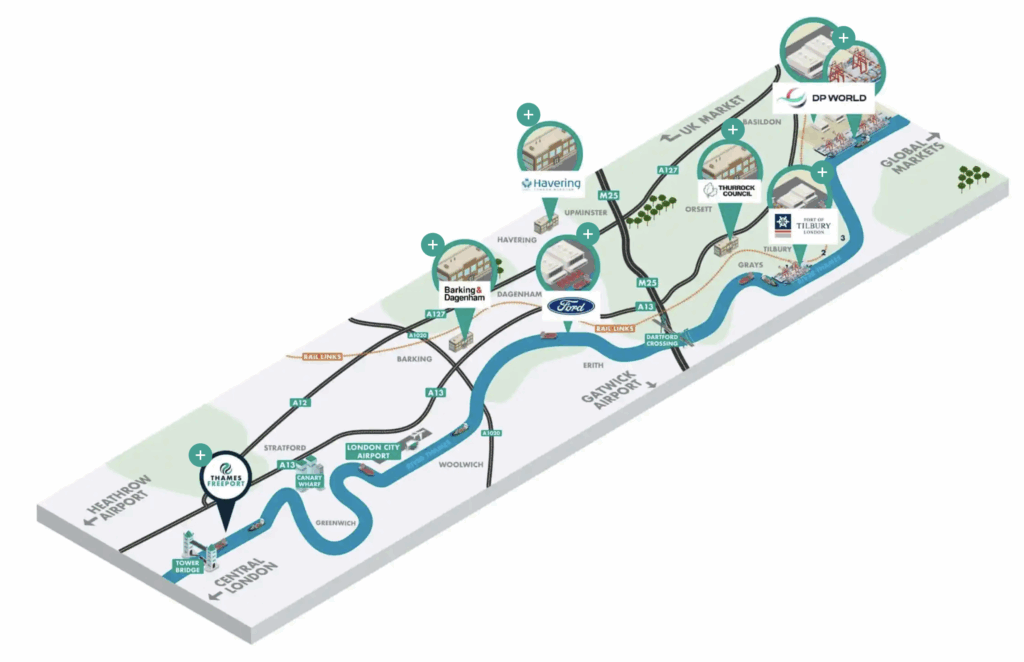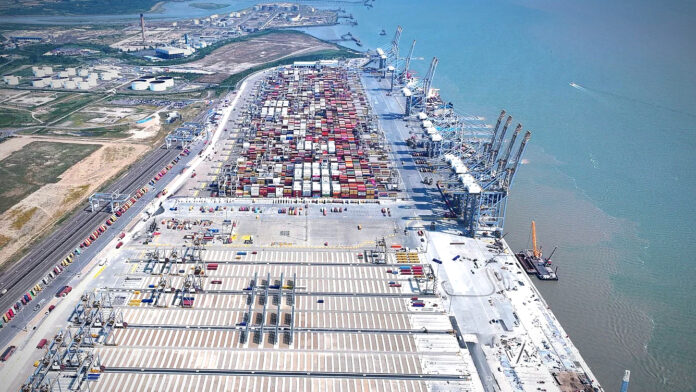Verizon and Nokia will deploy six private 5G networks across Thames Freeport’s port logistics and manufacturing hubs in the UK, powering AI, IoT, and automation across 1,700 acres in a landmark transformation deal.
In sum – what to know:
Six networks, three sites – Verizon and Nokia will deploy private 5G at key industrial sites at the Port of Tilbury, London Gateway, and Ford’s Dagenham plant.
All edge, all 5G – networks will use 3.8-4.2 GHz spectrum and edge-5G systems with full geo-redundancy to support AI and IoT across 1,700 acres along Thames.
Blue-riband deal – a major coup for Verizon Business, signed under the noses of its UK rivals, which sees it reprise a foreign ports collaboration which started way back in 2021.
Verizon and Nokia have just landed a monster deal in the private networks game: the duo will work together to design and deploy around five private 5G networks at three different maritime logistics and manufacturing sites outside of London, along the north bank of the Thames Estuary, east of the UK capital. The contract is with Thames Freeport, which manages the Port of Tilbury, Ford’s Dagenham plant, and the London Gateway complex. Verizon Business will lead the deployments at each site, using Nokia’s private 5G and edge systems.
The Port of Tilbury, the largest port on the Thames, and London’s main shipping hub, will have two private 5G networks. London Gateway, branded DP World London Gateway, a little east along the estuary, will also have two private 5G networks, to cover the deep-water container terminal and the logistics park. DP World London Gateway is presented as the “UK’s largest and most integrated logistics facility”. As well, Ford’s Dagenham plant, the other side of the Dartford river crossing, will have a private 5G network, as well. It is the largest manufacturing site in London.
The entire setup will comprise about 80 private 5G radios, RCR Wireless understands. The remit also includes a synchronized geo-redundant core network, as the sixth core network deployment effectively, across the Thames Freeport area – of about 1,700 acres of land. “All [the sites] will have multiple geo-redundant cores for failover,” said Verizon Business. DP World London Gateway also includes a busy rail terminal; it is unclear, as yet, whether this will also be connected. Verizon Business suggested the project “could evolve as the implementation progresses”.
The networks will use the 3.8-4.2 GHz spectrum band, reserved in the UK for private and shared network usage by enterprises. They will be entirely 5G-based; there is no room for LTE/4G, apparently. “Because Thames Freeport wants to be ahead of the technology curve,” explained Jennifer Artley, senior vice president of ‘5G acceleration’ at Verizon Business, speaking with RCR Wireless ahead of the announcement. “It doesn’t want yesterday’s tech for tomorrow’s transformation. 5G supports its immediate needs, and also provides flexibility to grow.”
There is no scope within the project, at the outset, for any other wireless connectivity technology, either – whether Wi-Fi or LoRaWAN, or anything else. “Everything is private network based,” said Artley. There are no neutral-host elements, either. Nokia will supply its Digital Automation Cloud (DAC) core network system, attached to its Mission Critical Industrial Edge (MXIE) compute blades in each case. It will supply the radios, alongside. There is no word on whether Thames Freeport will make use of the Finnish vendor’s stable of MXIE applications – yet.
The deal is fresh, signed in the last couple of weeks – after several years of discussion (“since 2023”), culminating in a tender process where Verizon Business presumably went up against the business divisions of UK-based mobile operators. This is unconfirmed, and Verizon Business refused to comment beyond a reference to the “usual suspects”. “Boots are just hitting the ground now,” said Artley. “The intention is to move quickly.” A six-month timeframe on the deployment seems about right; although, again, Verizon Business would not be drawn.
Certainly, from a telco-industry point of view, it is a feather-in-the-cap for both Verizon Business and Nokia – a major multi-site contract, and an ambitious project. It might be noted that the two parties have worked together since 2021 at Associated British Ports, covering a private ‘5G’ deployment at the Port of Southampton, on the UK’s south coast. That was Verizon’s first European private-networks contract, and it sent a frisson through the UK mobile operator community – that it could rock up in their backyard, hook up to the newly-liberated 3.8-4.2 GHz band, and win.
Nokia, of course, has a long history in the ports and maritime logistics industry; this new wave of private 4G/5G activity, as enterprise spectrum has come available and cellular systems have shrunk-down, can be traced back to its pioneering work at the end of the last decade with the Finnish ports of Kokkola, HaminaKotka, and Oulu (Nokia’s hometown) – mostly with Ukkoverkot (which became Edzcom, acquired by Cellnex, then Boldyn Networks), and frequently with Athonet (now part of HPE). It has worked with Verizon Business at various ports, including in the US.
Artley commented: “That government regulated spectrum, accessible to enterprises, means we can operate as a non-traditional carrier in the market. That is not the case everywhere – as it is in Europe. It was a competitive bid, which was complex – because we are providing a technology foundation for multiple stakeholders, all with different objectives to have a private network. But we have good experience in ports, including in the UK with Nokia – which is an excellent partner, which we also have a long history with out-of-region.”
She added, about how applications are likely to scale: “We know there are a myriad of use cases that come very quickly in ports once the network is deployed. It might start with push-to-talk, and then go on to health and safety, and then expand from there. There is so much you can do from a logistics management perspective. And the vision at Thames Freeport is huge; it could not be more ambitious in terms of what is being planned for the tenants of the port, and also the people of the region.”
Indeed, from an enterprise point of view, the scope of the Thames Freeport project is ambitious – presented as “London’s most significant opportunity in a generation”. Martin Whiteley, chief executive at Thames Freeport, has set out a plan to stimulate trade, foster innovation, support energy transition, and boost local communities in London, and boroughs to the east. As a government-designated ‘freeport’, it has special economic status so imported goods are free from taxes – as a way to boost trade. It has a brief to revive the Thames Estuary region, as part of the deal.
Whiteley commented: “Connectivity… is critical to our long-term vision. Our investment in private 5G is not an incremental network upgrade – it is the backbone of a technological transformation fueling our long-term multi-stakeholder mission, which includes: operational excellence for tenants, ROI for shareholders like Ford, DP World and Forth Port; innovation leadership for public and private benefit; and circular economy models supporting efficient energy models… With Verizon Business and Nokia, we’re delivering the tech… to propel our region.”

Thames Freeport has received about £2.5 billion of funding over the course of the last decade; another £3 billion of investment is planned, apparently. It has created 1,400 jobs, and has a target to create 5,000 in total by 2030. The new private 5G infrastructure will be all hosted on site, “under the direct control” of Thames Freeport and its tenant-shareholder organisations. The network foundation will host “technology layers such as AI, edge computing, and IoT”, said a statement.
A list of use cases variously includes: autonomous yard tractors and quay cranes on the port areas (“autonomous vehicle control”); smarter tracking, routing, and monitoring of goods and cargo (“real time logistics orchestration”); plus “environmental edge-connected” IoT sensors and AI analytics to optimize port operations for performance and sustainability (“including near-real time monitoring of emissions, air and water quality, and noise levels”. There is a whole R&D and innovation angle, as well, plus an AI infrastructure project.
David de Lancellotti, vice president of enterprise campus edge sales at Nokia, said: “Private wireless and industrial edge are the foundations for the digital transformation of industrial sites, and the Thames Freeport deployment is a landmark example of this evolution at scale. This network will allow [it] to overlay advanced use cases such as AI-driven data analytics, predictive maintenance, process automation, autonomous vehicle control, safety monitoring, and real-time logistics orchestration.”
Artley added: “Our partnership with Thames Freeport and Nokia shows the full promise of private 5G at scale. Thames Freeport is developing one of the most technologically advanced commercial corridors in Europe to enable forward innovation and economic revitalization for an entire community. We’re not just driving operational improvements to help a partner stay ahead of the curve; we’re laying the groundwork for new revenue streams, community development, and further commercial and technological investment.”
The deep-sea port at DP World London Gateway, opened in 2013, has capacity to handle 3.5 million twenty-foot equivalent container units (TEUs) per year. The DP World Logistics Park at the same site covers 9.25 million square feet, and also connects to London and the rest of the UK by rail. The Port of Tilbury, operated by Forth Ports, is the largest of the mixed-use Thames Freeport ports, and handles 16 million tonnes of cargo per year across 31 independent working terminals. As above, Ford Dagenham is the largest manufacturing site in London.

